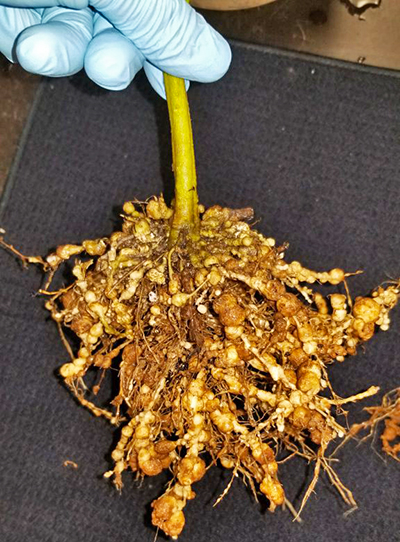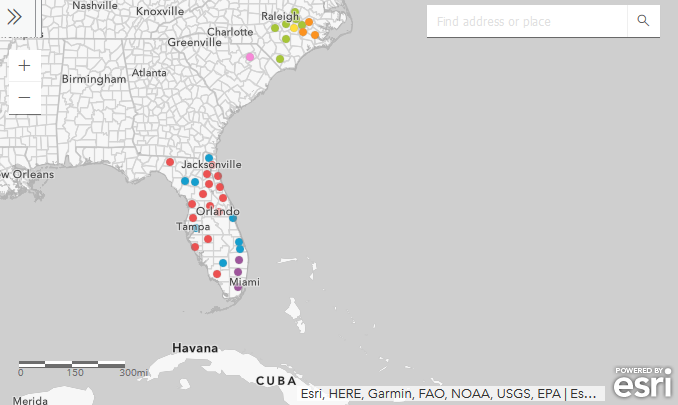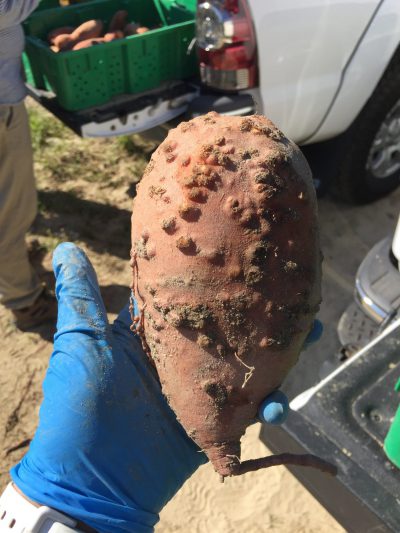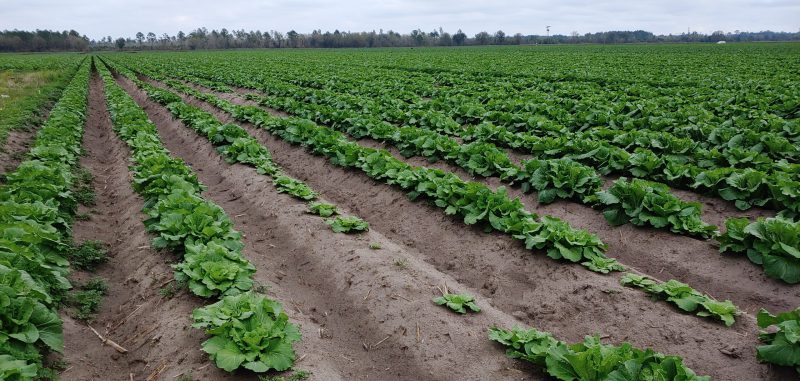Zane Grabau, Crop Nematologist, and Chang Liu, BioScientist, UF/IFAS Entomology & Nematology Department–
–

Figure 1. Extensive galling of tomato roots by guava root-knot nematode. Photo by David Moreira Calixguava root-knot nematode.
Guava root-knot nematode (Meloidogyne enterolobii) is an invasive pest that has received increased attention and concern in recent years. This article describes this pest and what you need to know about it.
–
What is the guava root-knot nematode?
Guava root-knot nematode (GRKN) is a tropical/subtropical species of root-knot nematode. It is a cause for concern for two primary reasons: (1) It can reproduce and damage cultivars that are resistant to other root-knot nematodes. (2) It causes more severe root galling than other root-knot nematode species on some crops (Figure 1), which may indicate more substantial yield loss. In the southeast, common root-knot nematode species on field crops are southern root-knot nematode, peanut root-knot nematode and Javanese root-knot nematode. Unlike the other root-knot nematode species, GRKN is not yet widespread in the US, and was likely introduced from another country. Guava root-knot nematode was first reported in Florida in 2004 and has since been identified in most counties in Peninsular Florida (Figure 2).

Figure 2. Southeastern counties with confirmed guava root-knot nematode. Dots indicate confirmed counties. From https://www.findmenematode.org/
–
Why all the recent attention?
The discovery of GRKN in North Carolina sweetpotato production (2011 first report for state, since confirmed in 16 counties), and subsequent confirmation in individual parishes or counties in Louisiana and South Carolina (2018) triggered the recent attention. These reports prompted an internal quarantine and certification program for sweetpotato slips in North Carolina. Louisiana, Mississippi, and Arkansas also issued quarantines on shipment of sweetpotatoes from North Carolina, South Carolina, and Florida (states with confirmed GRKN). These quarantines have increased awareness and concern about GRKN. In addition, GRKN has caught the attention of the sweetpotato industry because the moderately-resistant sweetpotato cultivars used extensively are not effective against GRKN.
–
What crops can be affected by guava root-knot nematode?
Based on testing thus far, guava root-knot nematode affects most crops, with a host range similar to southern root-knot nematode. Most horticulture (potato, sweetpotato, tomato, pepper, squash, melons, etc.) and ornamental (bulbs, annuals, etc.) crops are hosts (affected by GRKN). Among common agronomic crops, cotton, soybean, and tobacco are hosts. Corn and peanut are not hosts based on current knowledge.
Root-knot nematode resistant cultivars are probably the most important hosts of GRKN as this pest’s ability to damage resistant cultivars is a primary reason it is a greater concern than common root-knot nematode species. Guava root-knot nematode can reproduce on resistant cultivars of cotton, sweetpotato, soybean, tomato, bell pepper, sweet pepper, and cowpea.
–
How do I know if I have guava root-knot nematode in my field?

Figure 3. Galling on sweetpotato tubers caused by guava root-knot nematode. Photograph by Camilo Parada
Guava root-knot nematode cannot be differentiated from other nematodes based only on field symptoms or standard testing. Rather, molecular diagnosis—more extensive than routine testing and most easily done on nematodes extracted from roots—by a professional nematology laboratory is needed to determine if GRKN is present in your field. For Florida fields, if you suspect GRKN or want to know what root-knot nematode species is in a particular field, contact the authors of this paper and your local Extension Agent. The authors are conducting research on GRKN distribution in Florida and are eager to assist with diagnosis. The UF nematode assay lab can also conduct this diagnosis. Be aware of root-knot nematode infection symptoms to help guide when further testing is needed. Root galling (Figure 3) is a characteristic symptom of root-knot nematode infestation and yellowing, wilting, collapse, or stunting of foliage are also common symptoms. Prolific galling and infection of resistant cultivars (Figure 4) are two factors to watch for that suggest—but do not prove—that GRKN may be present. Many resistant cultivars have only partial resistance or only affect a single species. (For example, most resistant soybean cultivars are effective against southern root-knot nematode but are very susceptible to peanut root-knot nematode.)

Figure 4. Stunting, reduced stand, and yellowing of napa cabbage caused by root-knot nematodes. Photo by Zane Grabau.
–
How can the guava root-knot nematode be managed?

Figure 5. Galling from guava root-knot nematode on a nematode-resistant pepper cultivar. Credit: Zane Grabau, UF/IFAS.
Because GRKN has a relatively limited distribution, measures to limit the spread of GRKN are particularly important. State regulations address this on a regional level. On an individual level, control measures include using nematode-free planting material and limiting soil and plant movement among fields. Once a field becomes infested with GRKN, crop rotation and nematicide application are the primary options to reduce nematode abundances and crop damage. The efficacy of these practices are well-established from extensive research with other nematodes. However, more field testing is needed to optimize these practices for GRKN. For example, the host status of some crops for GRKN needs to be determined and nematicide rates may need to be adjusted for the aggressive GRKN.
The authors acknowledge support from USDA-NIFA SCRI grant #2019-51181-30018
For more information on guava root-knot nematode, including research updates from the grant, see https://www.findmenematode.org/
